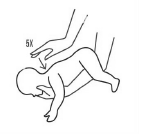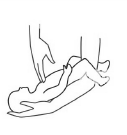What should I do if my child is choking?
Young children often choke on small objects. “Is it a good idea to give a choking child a glass of water or something to eat?” How many of us know that we
shouldn’t as it will not dislodge the blockage and may make the situation worse by causing a further blockage?
Learning about how to provide first aid really is one of the simplest yet most effective ways you can keep your little ones safe. When it comes to managing the unexpected, we know first hand that every second counts! Let’s come together to learn, share, and spread the knowledge of first aid for when emergency strikes.
First aid for conscious choking
- It is important to act quickly and calmly if you suspect that a young child is choking, the key is to stay calm and assess the situation.
- Choking may cause airway blockage, coughing is the best way to clear a partially blocked airway.
- If the child is coughing or making noises, encourage them to continue coughing and try to clear the blockage on their own
- If your child’s still conscious, but they’re not coughing or their coughing isn’t effective, the airway may be totally blocked and help is needed- use back
blows.
Signs of conscious choking:
- Difficulty breathing
- Unable to cough
- Inability to cry or speak
- Bluish skin color or lips
- High pitched sounds while inhaling
- Have a red puffy face
- Show signs of distress
STEP 1: Give up to 5 back blows
For infants (1 year and under):
- Hold the baby face-down with head lower than the body.
- Making sure you support their head and their neck.
- Using the heel of your hand, give up to 5 back blows on the baby’s back between the shoulder blades, gently with firm pressure.

For children (1 year to puberty):
- 1. Help them to lean forward- place your arm across the child’s chest to support their upper body.
- With the flat of your hand, give the child 5 back slaps between the shoulder blades.
- Use gentle yet firm pressure.
If the back blows don’t work, move on to giving some thrusts…
The Heimlich Maneuver, also known as abdominal thrusts, is a first-aid procedure used for airway obstruction (choking) in adults and children but not recommended for infants under 1 year old.
STEP 2: Give up to 5 thrusts
For infants (chest thrusts)
- Turn the baby over, so the baby is lying with face up
- Always make sure that their head and neck are supported
- Give up to 5 chest thrusts using 2 fingers, fast and hard, on the baby’s breast bone just below the nipple line.

For children (abdominal thrusts)
- Stand behind the child, place one foot slightly in front of the other for balance.
- Wrap your arms around the child’s waist.
- Clench your fist and place it just above the child’s belly button but below the ribcage.
- Use your other hand to grasp your fist and press inward and upward with a quick, forceful motion.
STEP 3:
- Call 999 if the blockage doesn’t dislodge.
- Repeat the cycles of 5 back blows and 5 abdominal thrusts until the blockage dislodges or help arrives.
First aid for who is unresponsive and not breathing
If one does not respond when you call them or tap their shoulders, they are unresponsive.
- Shout for help (to call 999).
- Commence cardiopulmonary resuscitation (CPR) with chest compressions.
- Ask a helper to find and bring a defibrillator if available- gives clear instructions what to do
- Open airway
- Check for any blockages such as food, vomit, blood or loose teeth in the mouth and remove it if visible (never put fingers down their throat or sweep the mouth as this can push the obstruction further down).
- Take the tongue off the back of the airway.
- Open the airway by gently lifting the chin (use 2 fingers) and tilt their head back so that the head and neck remain in a neutral position.
- Check for breathing
- Look: For the rise and fall of the chest or abdomen
- Listen: For air escaping the nose and mouth
- Feel: For the movement of air from the nose and mouth
- If they are not breathing, start CPR immediately
STEP 1: Give 5 rescue breaths
For infants (1 year and under):
- Seal your mouth around the baby’s mouth and nose.
- Blow into both mouth and nose gently until the chest rises.
- Remove your mouth and watch the chest fall, repeat this for 5 times.
For children (1 year to puberty):
- Pinch their nose and seal your mouth over their mouth.
- Blow into the child’s mouth steadily until the chest rises, remove your mouth and watch the chest fall.
- Do this for 5 times to re-oxygenate them.
STEP 2: Chest compressions
For infants:
- Position 2 fingers in the center of the chest around the nipple line.
- Push down firmly in the middle of their chest with one hand (about a third of the depth of the chest).
- Allow the chest to return to its normal position after each compression.
- Repeat this for 30 times at a rate of 100- 120 compressions per minute.
- Give 2 rescue breaths.
- Continue with cycles of 30 chest compressions and 2 rescue breaths until help arrives.
For children:
- Kneel by the child, place the heel of one hand in the center of the child’s chest.
- Push down firmly in the middle of their chest with one hand (about 2 inches or a third of the depth of the chest).
- Allow the chest to return to its normal position after each compression.
- Repeat this for 30 times at a rate of 100 to 120 compressions per minute.
- You can use both hands for children 8 years old and above.
- Give 2 rescue breaths.
- Continue with cycles of 30 chest compressions and 2 rescue breaths until help arrives.
Prevention is always the best course of action. Parents and caregivers can help prevent situations that may cause choking by ensuring that small objects that can fit in the mouth are kept out of reach of children or order developmentally appropriate foods and monitor them closely during mealtime (ensure children chew slowly).
However, having first aid knowledge is highly beneficial for every parent as an essential skill as they can respond quickly and calmly in case of an emergency, potentially saving a life. The information provided here is a general guide, it’s important to attend a first aid course and consult certified first aid training resources for up-to-date instructions on first aid for choking emergencies.